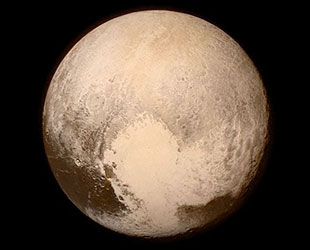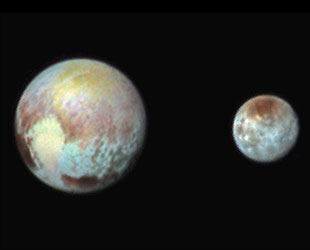July 14, 2015 – NASA's New Horizons probe successfully flew past Pluto on Tuesday (July 14), becoming the first spacecraft in history to visit the orangish-red dwarf planet. The flyby crowned humanity's first reconnaissance of the solar system's nine major worlds.
The piano-sized probe made its closest approach of 7,750 miles (12,500 km) to Pluto at 7:49 a.m. EDT (1149 GMT), collecting imagery and science data as it soared past the small planet. About nine hours later, New Horizons turned its antenna dish away from the Pluto system and towards Earth so that it could "phone home" to confirm it survived the historic encounter.
That highly-anticipated call was received at 8:52 p.m. EDT (0052 GMT) to the visible and vocal elation of the mission operations and science team at Johns Hopkins University Applied Physics Laboratory in Maryland. Traveling at the speed of light, it still took 4 hours and 25 minutes for the signal to travel the more than 3 billion miles (5 billion km) from the spacecraft back to Earth.
"We have a healthy spacecraft," reported Alice Bowman, New Horizons' mission operations manager, based on the telemetry that was received. "We have recorded data from the Pluto system and are outbound from Pluto."

New Horizons' last and most detailed image of Pluto as captured on July 13 before its closest approach. (NASA/JHUAPL/SWRI) |
The call only included engineering data about the health of the spacecraft. Science data, including the imagery taken during the flyby, will begin being transmitted to Earth later Tuesday night to be seen Wednesday and then, due to the data transfer rate, will continue into next year.
"Tomorrow morning, we should see the beginning of a 16-month data waterfall," New Horizons' principal investigator Alan Stern said. "You will be seeing more and more about Pluto beginning tomorrow."
By the time the call was received on Earth, New Horizons had traveled 400,000 miles (640,000 km) beyond Pluto. In addition to mapping the composition and sunlit surface of the planet and its moon Charon during the close approach, the probe also tried mapping Pluto's night side, illuminated only by Charon's reflected moonlight, as it moved outward.
The spacecraft was also to use its antenna to intercept a radio beam from Earth, aimed such that it passed through Pluto's atmosphere. By measuring the effects of refraction on the radio beam, mission scientists will be able to map the atmosphere's temperature, density and composition all the way to the surface.
New Horizons' images of Pluto taken before the flyby have already brought the dwarf planet into better focus.

New Horizons images of Pluto and Charon shown in exaggerated colors to highlight compositional diversity. (NASA/JHUAPL/SWRI) |
"It has a thin, or rarified nitrogen atmosphere," Stern said. "You can see regions of various kinds of brightness: there are very dark regions near the equator, very bright regions just to the north of that, [and] a broad intermediate zone over the pole."
"On the surface we can see a history of impacts. We see a history of surface activity in terms of some features that we might be able to identify as tectonic, indicating internal activity in the planet at some point in its past, and maybe even in its present," he added.
"We also know this is clearly a world where both geology and atmospheric climatology play a role."
As New Horizons sends back the data collected during the Pluto flyby, it will continue to move out into and eventually beyond the third zone of the solar system, the Kuiper belt.
"Over the next 20 years, if it continues to be healthy, the spacecraft could operate and return scientific data, first from a potential Kuiper Belt flyby of a small planetesimal — the building blocks for planets like Pluto, and then we have a chance to go further to explore the deep reaches of the heliosphere," said Stern.

A coffee mug celebrating New Horizons' Pluto flyby is seen after a media briefing on July 14. (NASA/Bill Ingalls) |
The New Horizons team, using observations made by the Hubble Telescope, have identified two Kuiper Belt objects, each about the size of Pluto's moon Hydra, that the probe could possibly encounter. The unnamed bodies (the team refers to them internally as potential target, or PT, one and three) are in orbits such that the probe could reach either using its remaining fuel supply in 2019.
"In the fall, in late October or early November, we will start burning [New Horizons'] engines," Stern said. "We have to choose between them [PT1 or PT3] in August so that we can design the burns and then we'll be able to push to one or the other."
NASA still needs to approve the budget for the operations to support the Kuiper Belt object encounter.
For now though, the focus is on Tuesday's historic flyby.
"I have to pinch myself — look at what we accomplished," Bowman said. "It is truly amazing that humankind can go out and explore these worlds. To see Pluto revealed just before our eyes, it is just fantastic. I can't wait until we get the images down."
